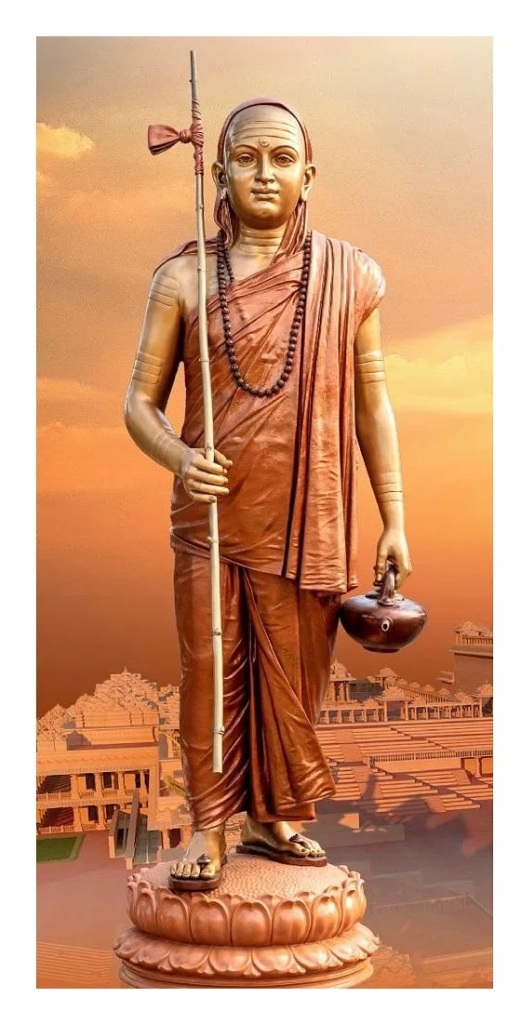“Moral Values depicted in Sanskrit literature” – National Seminar held at Sri Poornaprajna College, Udipi on December 19th and 20th, 2014.
The National seminar on “Moral Values depicted in Sanskrit literature” was inaugurated in the Poornaprajna auditorium situated on the left side of the Poornaprajna College campus.

2. Poornaprajna auditorium where the seminar eas inagurated
The Poornaprajna auditorium was constructed and inagurated[1] in commemoration of the 50th birthday of H. H. Sri Vibhudhesa Theertha Swamiji of the Admar Mutt on 24-10-1986.

3. Poornaprajna auditorium – 24-10-1986 started
The delegates were accommodated at the Admar Mutt Guest House situated very near to the Udupi Krishna Temple and the venue of the seminar.

1. Admar Mutt Guest Houre-where the delegates accommodated
The seminar was sponsored by the UGC and organized by the Department of Sanskrit, Poornaprajna College, Udupi in association with the Mangalore University Sanskrit Teachers’ Association.

Breakfast served by the smiling students-volunteers
The registration of the delegates was done at the entrance separately for the Resource persons, lecturers and others.

4. Registration of the delegates 19-12-2014
They categorized and kept the kits ready accordingly.

5. Registration of the delegates-Dec.19,2014
Inaugural function: The program started on December 19th morning with invocation prayer song “Peenayamom Vasudevam” by Gargi Shabharya & party. Dr. Ramesh T. S. HOD Sanskrit Department PPC welcomed the delegates, invitees and others[2]. Dr. Shrinivasa Varkhedi, Hon’able Vice Chancellor of Karnataka Sanskrit University, Bengaluru and Dr. G. S. Chandrashekhar Hon. Secretary, PCMC, Udupi were the guests of honour[3]. Dr. B. Jagadeesh Shetty gave introduction of the guests and Prof. K. Sadashiva Rao Principal of the college presided over the function. The VIPs on the dias were – Swamiji, Manjunatha Bhatta, G. S. Chandrasekhar, Srinivasa Varkhedi, Vishnu Potty, K. Sadashiva Rao, T. S. Ramesh Udupa.
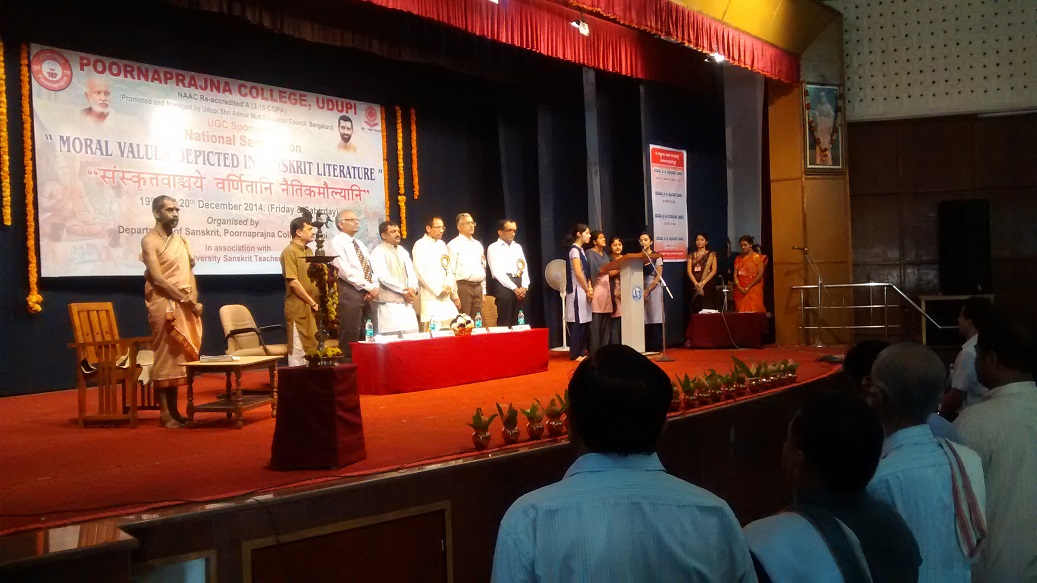
6. During prayer-19-12-2014
Sri Vishnupriya Theertha Swamiji graced the inaugural function – standing up for prayer.

7. Prayer-Ramesh, Chandarsekhar, Varkhedy
Dr / Prof Ramesh Udupa, Chandarsekhar, Varkhedy addressing the gathering after the sppech of Swamiji.
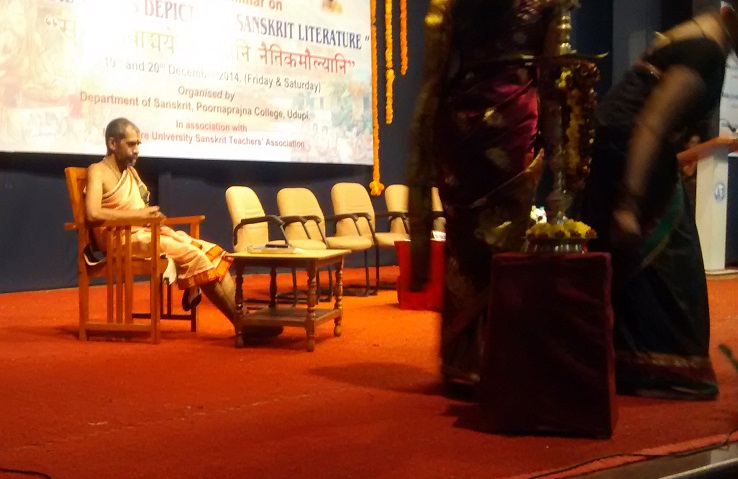
8. H H Sri Viswapriya Swamiji came to inaugurate
First Swamiji came and then the VIPs also came to the dais.

9. Section of the audience-before inauguration
K. Sadasiva Rao, Varkhedy, Vishnu Pothy, and Pradeepkumar

10. Section of the audience- inauguration-other view
Another view of the audience.
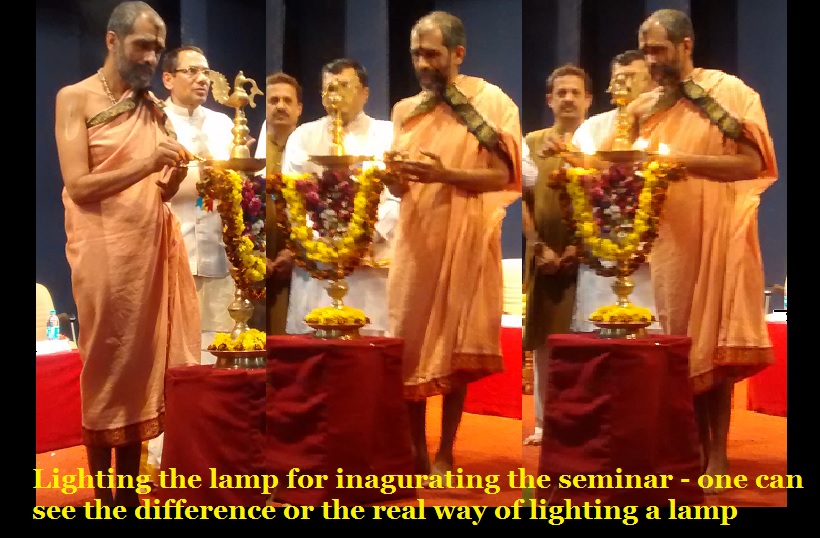
11. Lighting the lamp for inaugurating the seminar
Lamp was lit traditionally.

12. Swamiji giving speech
After lighting lamp, Swamiji started his speech.

13. Swamijis characteristic speech
Swamiji’s expressive and characteristic speech.
10.30-10.42 am: Sri Vishnupriya Theertha Swamiji, president, Udupi Sri Admar Math Education Council, inaugurated the Seminar with his inspiring speech in Sanskrit. The language spoke by him had been so lucid that could be understood by everybody. Of course, he spoke in between in English and Kannada also driving the point. He pointed out that the etymological roots of Sanskrit were there in all languages of the world. The pure language was Sanskrit and when it was mixed with local speeches of the local people at different parts, it became less Sanskrit like Hindi, Marathi, Gujarathi and so on. Hindu culture nurtures Samskaras and lives with Samaskaras followed. Nowadays, there was a demand for the appointment of Archakas in temples to conduct pujas reciting in local languages. No doubt, it could be done, so that the local people could understand, yet, the importance and significamce of Sanskrit cannot be ignored. As we speak different mother tongues, Sanskrit was spoken by all, when there was Vedic culture. At that time Sanskrit was the serving language to the God, but, slowly, it was changed. Now Sanskrit is going out of India, as could be noted from a claim of an American professor[4], who claimed that he could teach Sanskrit to Indians. Without naming, he pointed out how he arrogantly declared calling, “Hey, Bharatiya, come to me, I shall teach Sanskrit to you”! Ironically, our Indians clapped for such sanctimonous and pompus speech. Should we not have felt shame for that, Swamiji asked. Now, the mention of “Bhagawat Gita” as national book has provoked many and they started objecting to it, but, they knew that our national song, animal, bird etc., had been so. Therefore, there is nothing wrong in it. He stressed that Indians should follow Samskaras to protect their culture and inculcate moral values.
10.45 to 11.15 am: Vishnu Potty, Vice Chancellor of Sri Chandrashekhara Saraswati Mahavidyalaya, Kanchipuram, Tamil Nadu spoke pointing out the significance of Indian family system. As it was broken, there was degradation of moral values in all spheres of society. He said that the country was known for its strong family values. The family was its core institution. But due to increasing Western influence, the family as an institution was collapsing. This was a cause for concern. Along with education, it was necessary to teach skills to students, which would give them courage and confidence to deal with different types of situations[5]. The modern gadgets have also been affecting the youngsters, he pointed out giving an example of “missed call” syndrome. An individual looses morality and discipline because of the collapse of value system. As he tried to speak extempore, deviating from his prepared sppech, he started telling generalised issues. However, his paper “Modern Problems and Ancient Solutions” was circulated. He concluded that the Sanskrit literature was replete with lots of positive prescriptions to every sort of practical modern day challenges that an individual encounters in his personal, family, social and professional relationships.
11.15 to 11.45 am: Srinivasa Varkhedi, Hon’ble Vice Chancellor of Karnataka Sanskrit University, Bengaluru started with the details of Macaulay’s design to Westernize Indians with English education[6]. He also mentioned about the values of Indians. He said that we should change the education system to change the people at large. We should teach moral values and humanity to educated people rather than non educated one. One language can control the thinking of human. There need to proceed good moral values in life along with the education. In order to maintain our moral values in life one can understand the language of Sanskrit[7]. He expressed his anxiety that nowadays, all boys and girls entering schools might be subjected to checking before allowing inside (implying the killing of school children in Pakistan). It was the literate and educated people who needed to be told about moral values than illiterate and uneducated persons, he said[8]. He also revealed about a printed card circulated to the foreign visitors travelling in aeroplanes. The card warned that the women should be csareful and they should not go to streets alone. This he compared with the Macaulays statement that there was no thief in India[9]. Now, what the foreign women would think about Indians, he asked. The warning “Beware of…….” Made Indian men “dogs”! He explained the nuances of the title of the Seminar as mentioned in Sanskrit and English. The expression, “Sanskrutavangmeya varnani naitikamaulyani” had been the translation of “Moral values depicted in Sanskrit literature”, but there was no such expression “naitikamaulyani”, as it was nothing but “Dharma”. He gave one example of a sentence, “A glass broken” translated in the different European languages. As language was linked to thinking of man and it is called “thinking language”, only few languages could match the real translation conveying the exact meaning to others. He also elaborated the word “darshan” in the temple context, as it is different from seeing, observing, looking at etc. He also lamented as how Indians had forgotten about the values in treating women. Taking the response of Swami Vivekananda, he pointed out that Indians should respect women. When Swami Vivekananda was asked as tro why he did not marry, he replied that he could see only “Durga” in every woman and therefore, he could not marry.
Dr. Ananda Acharya proposed vote of thanks while Mrs. Vijayalakshi Department of Economics and Mrs Harinakshi Shetty Department of English compeered the program[10]. After lunch, the technical sessions started at three different places.

14.Special session – 19-12-2014 morning
Sanskrit scholars for Special session

15. Audience during the special session morning 19-12-2014.another view
Audience during the special session morning 19-12-2014

16. Audience during the special session morning 19-12-2014
Paper reading sessions (19-12-2014): The following papers were presented in parallel sessions:
From 4.00 to 6.30 pm at the Poornaprajna Mini Auditorium, the following papers were presented in Sanskrit:
| A. Sekhar Reddy, Tirupati, Seemandhra |
The Concept of Teaching in the Puranas |
| Aswathi Sudham Vamsi, Guntur, Seemandhra |
Moral values depicted in the Krishna Yajurveda-Dharmasutras |
| Y. S. Gayathri, Bangalore |
Moral values depicted in the Upanishads |
| A. Kumarasubsramanya Bhat, Mangalore |
Moral values depicted in the Taitriyaranyaka – second book |
| A. Lakshmi Arya, Tirupati, Seemandhra |
Moral values depicted in the Brahmanas |
| Sathyakrishna Bhat, Katilu |
Moral values depicted in the Rigvedic Akhsa-sukta |
| Vedaprakash Joshi, Tirupati, Seemandhra |
Moral values depicted in the Manusmriti |
| Sheikh Jamal Bhasha, Tirupati, Seemandhra |
Moral values depicted in the Sanskrit literary World. |
| Jayamanickya Shastri, Kanchipuram |
Sutras from Nyayadharshana usel to Human Life. |

17. M. K. Sridhar speaking in English 19-12-2014
From 4.00 to 6.30 pm at the PIM Auditorium, the following papers were presented in Sanskrit:
| K. S. Lakhsminarayana, Hyderabad |
Moral values in Abhignana Sakuntala |
| Krishna Kakalvar |
National progress as propounded in the Sanskrit Literature |
| H. R. Lakhsminarayana Bhatt, Mangalore |
Moral values depicted in Malavikaknimitra of Kalidas |
| M. Ravikishore, Tirupati |
Moral values in Abhignana Sakuntala |
| P. S. Mahaganapathi, Ujere |
Moral values depicted in Ramayana drama of Bhasya. |
| Manjunatha Bhat, karkal |
Moral values depicted in Bhaimiparinaya drama. |
| Shantala Viswas, Mangalore |
Moral values depicted in Panchatantra |
| N. Sridhar Bhat, Ujere |
Moral values depicted in Sanskrit literature in general |
| Vikanth keelkar, Sringeri |
Moral values depicted in Sanskrit literature. |

18 Jena of Kanchipuram reading his paper 19-12-2014
From 4.00 to 6.30 pm at the Seminar Hall, the following papers were presented in English:
| Debajyoti Jena, Kanchipuram |
Moral values as reflected in the characters of Abhijnanashakuntalam. |
| Manoranjan Senapati, Kamchipuram |
Human contentment – Psychological approach. |
| G. V. Kallapura, Keladi |
Keladi Chennamaji’s Preachings |
| K. V. Ramakrishna Rao, Chennai |
A Critical Study of “Kalivarjyas” or thr prohibitions introduced during the Kali Age. |
| Surekha, Kateelu |
The Eternal love of Parvati in Kumarasambavam. |
| Umesh Sastri, Kumuta |
Moral values depicted in Pratijnayougandharayanam and Swapnavasavadattam. |
| M. Venkatesh Giri, Karwar |
Moral values depicted in Hitopadesa. |
| Manjunatha M. Bhat, Subramanya. |
Life-value- A reading of the Mahakavya-Kiratarjuneyam. |
| Sujatha Raghavan, Kanchipuram |
Contro of sences in Viduraniti. |

19. Paper reading session-English.2
Paper reading session (English)- a view of the audience.

20. 19-12-2014 -music programme
Dec.19th evening, Carnatic music was rendered by Mrs Bhat at the Udupi temple auditorium.
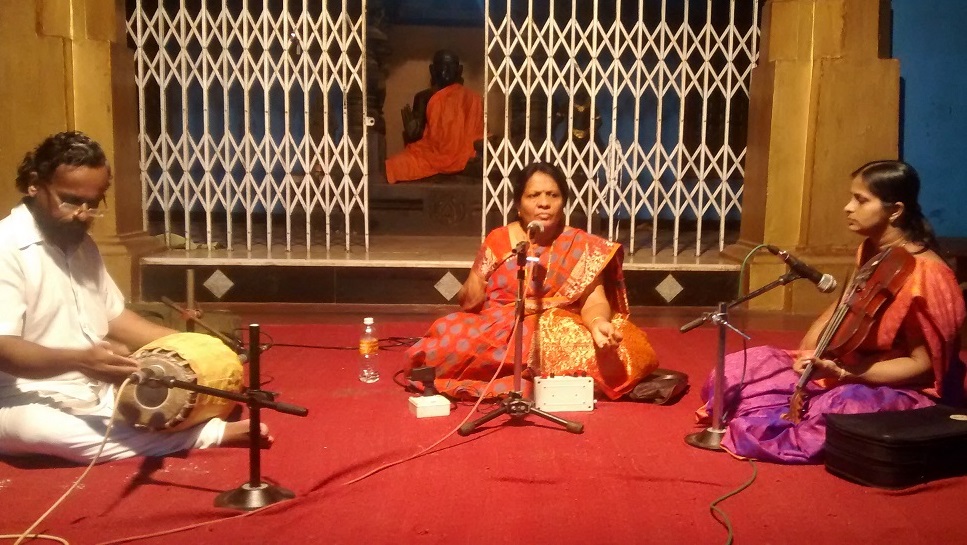
21. 19-12-2014 evening -Karnatic at Udupi temple Auditorium
Closer view of the singer and instrumentalists.

22. Paper reading session-English.3
Another section of the audience during the paper reading session

Paper reading session 19-12-2014 English.another view
Another view of the audience

Paper reading session 19-12-2014 English
Paper reading sessions on December 20, 2014: The second day also, the papers were presented in parallel sessions in Sanskrit and English.
From 8.30 to 10.30 pm at the Poornaprajna Mini Auditorium, the following papers were presened in Sanskrit:
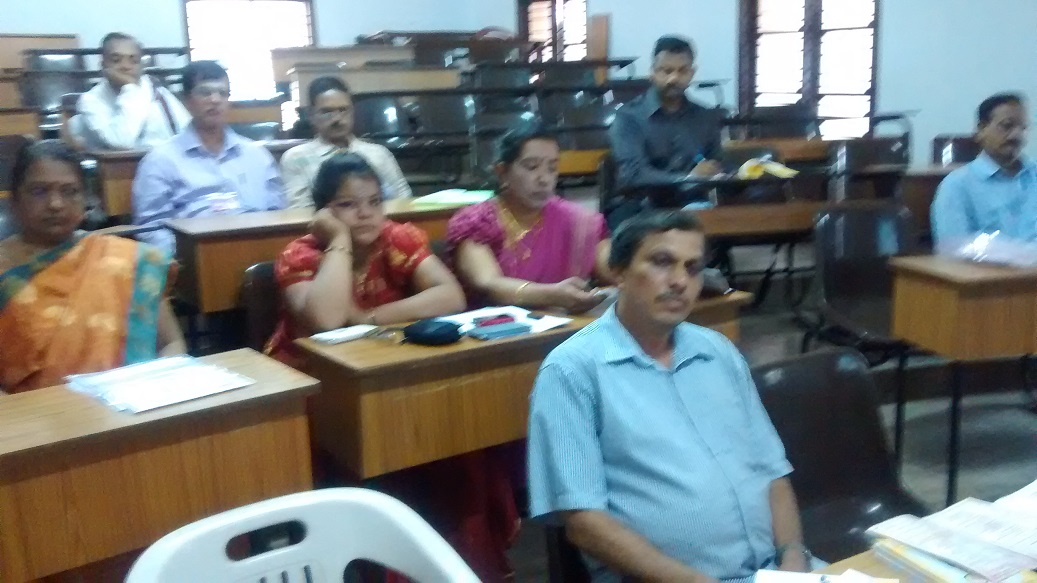
23. Paper reading session-English
| Amrutesh Acharya, Udupi |
Moral values depicted in Harvamsam. |
| Vikash Swayi, Shimogha |
Moral values depicted in Purnagnana Grantham. |
| D. Ravindra Babu, Tirupati |
Moral values depicted in Udhyogaparva of Mahabharata. |
| Vinayaka Bhat, Galimane |
Moral values depicted in Bhagawat Gita |
| P. K. S. Pawan Kumar, Tirupati |
Moral values depicted in Mahabharata |
| Ramakrishna Udupa, Udupi |
Moral values depicted in Bhagawat Gita |
| Guru Madhwacharya, Kalabhurgi |
Success in Life according to Madhvoktayaha. |
| Srikanth R. Ballitallaya, Mysore |
Moral values depicted in Mahabharata according to Saints. |

24. Swamiji attends each session listening to paper presentation
From 8.30 to 10.30 pm at the PIM Auditorium, the following papers were presened in Sanskrit:
| Gayathri, Mysore |
Moral values depicted in Raghuvamsa of Kalidsas |
| Kanduri Rajiv Kumar, Tirupati |
Moral values depicted in Santesh-kavyas |
| Priyadharshini Mallula, Tirupati |
Moral values of Family as depicted in Ramayana. |
| H. Padhbhanaha, Shivamogha |
Moral values depicted in Naishadhe sahadhayanande. |
| Sambhulinga, Mysore |
Moral values depicted in Sundarakanda of Valmiki Ramayana. |
| C. H. Gururaja, Mysore |
Moral values depicted in Sri Rukminish-vijaya-mahakavya |
| N. Sridhar, Mysore |
Varmekhaha: Guniputraha |
| Vinayaka Bhat, Shirasi |
Moral values depicted in Nitisataka of Bharthahari |

25. Upanyaya-ghosti-Sanskrit session-20-12-2014
From 8.30 to 10.30 pm at the Seminar Hall, the following papers were presented in English:
| H. N. Veena, Hassan |
Composition of Ethical values through education- The Vedic example. |
| Jayaram Bhat, Kumuta |
Moral values in ancient Sanskrit literature and Modern world |
| Laxmikantha Mohrir, Belagavi |
Moral values as stated in Panchatantra |
| H. N. Vidya, Hassan |
Born to Die? Escalating girl child atrocities in India – Reflections on the Vedic lessons for girl child protection. |
| Parimala Chittor, Bengaluru |
Moral values depicted in Sanskrit Literature |
| M. K. Shreesha Kumar, Outtur |
Moral values depicted in Akshasukta of Rigveda. |
| R. Suresha, Mysuru |
The Vedas – from the perspective of Moral values. |
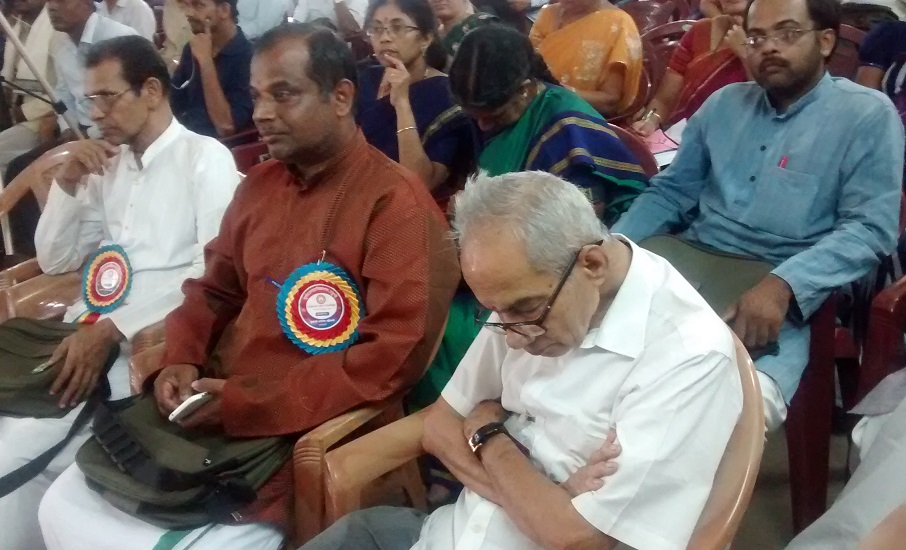
26. Upanyaya-ghosti-Sanskrit session-20-12-2014-audience.2
Upanyasaghoshti – Special lectures in Sanskrit: From 10.30 to 1.00 pm, special lectures in Sanskrit were arranged as follows at the Poornaprajna mini auditorium:
| T. N. Prabhakar, Bangaluru |
Moral values depicted in Vedas |
| Virupaksha Jaddipal, Tirupati |
Moral values depicted in Ramayana. |
| V. Prabhanjan Acharya, Bangaluru |
Moral values depicted in Mahabharata |
| T. V. Sathyanarayana, Mysuru |
Moral values depicted in Niti-kavyas |

27. Upanyaya-ghosti-Sanskrit session-20-12-2014-audience.3
Upanyaya-ghosti-Sanskrit session-20-12-2014-view of the audience.

28. Upanyaya-ghosti-Sanskrit session-20-12-2014-audience
Valedictory funcgtion (2.30 to 4.30 pm): Valedictory function was held in the same hall. Dr. N. Radhakrishna Bhat Rtd Prof and Chairman, DOS in Sanskrit, KSOU, Mysuru and Shri Pradeep Kumar Hon Treasurer, PCMC, Udupi were the guests of honour. Swamiji blessed the concluding function with his inspiring speech again. He presented mementoes personally to all the paper presenters with akshadha and fruit. He also blessed each and everyone in the hall with akshadha and fruit. His presence was there from the inauguration to valedictory of the seminar including paper reading sessions. Ramesh Udupa thanked all for the conduct of the seminar at every level.

29. Valedictory session-prayer-20-12-2014
On 20th afternoon, the valedictory function started with a prayer and graced by the Swamiji.
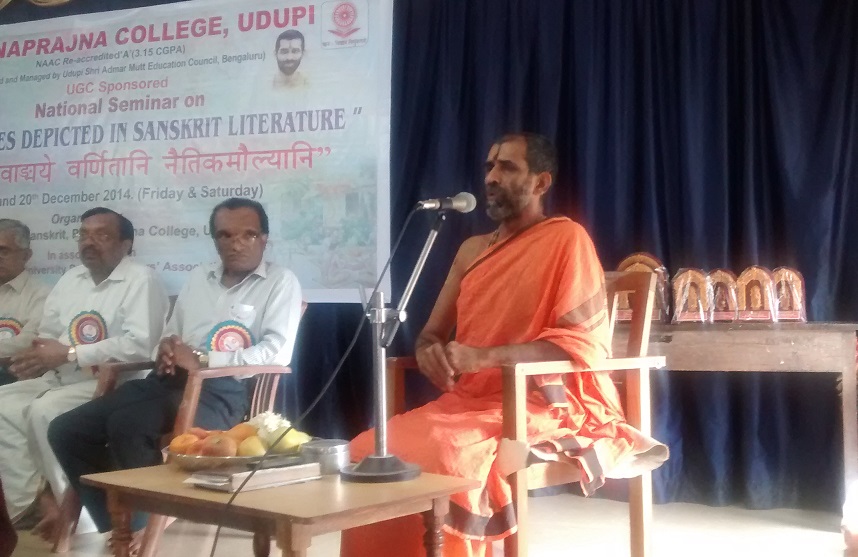
30. Valedictory session-Swamiji addresses-20-12-2014
After prayer, the Swamiji addressed the delegates giving his message.

33. Swamiji gives memento to K. V. Ramakrishna Rao
The Swamiji blessed the paper presenters with a memento, akshada and fruit.
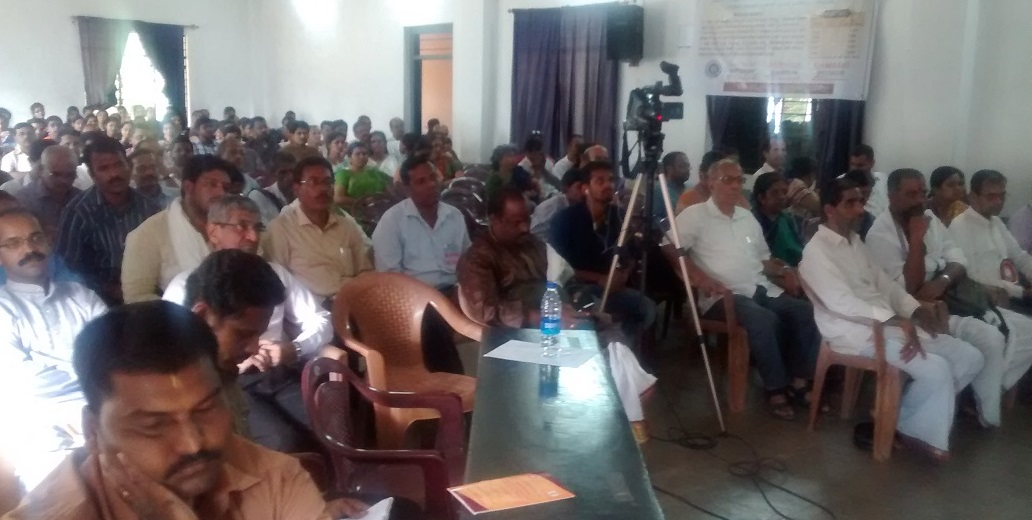
Audience during the valedictory function 20-12-2014
Audience during the valedictory function on 20-12-2014.
Papers presented in Sanskrit: The following obervations are made about the papers presented in Sanskrit:
- The Subject dealt with was repeated again and again by others, as could be seen from the title of the papers and the proceedings.
- Even the same topic, subject matter was taken by more than one or two persons and they did not change to tell something different from others.
- The Acharyas, Pundits and the like either spoke or presented papers as if they were addressing their equals who knew everything in Sankrit. They had indulged in their skill to recite slokas, explain the literary nuances etc., instead of reaching out all audience, particularly, who do not know Sanskrit.
- The slokas / verses recited, quoted or read have been so popular and known to researchers and others and therefore, they could have been avoided and spent the time in driving their point.
- Some had spent more time in explaing the slokas from kavyas about sringara and other aspects of God and Goddess; Hero and Heroine; and other characters, that amount to 80-90% of their presentation and then started listing out that so and so “moral values” were also depicted.
- They were making very generalized statements, presenting facts from the literature, instead of specifically pointing out their new findings or interpretations.
- Very few touched upon the necessity of the moral values depicted in Sanskrit literature useful to the current period.
Papers presented in English: The following obervations are made about the papers presented in English:
- The points 1,2, 4 and 5 as mentioned above are applicable here also.
- On 19th, the last speaker of the English session held at seminar hall started talking that all of the earlier speakers had already covered all points from Vithuraniti, Panchatantra, Hitopadesa etc., and nothing was left to him and therefore, he declared that he would talk anything he wanted. Thus, he started talking in a very general manner. Ironically, he did not bring any prepared paper.
- Scholars like Varkhedi, Bhat had been very specific that the presentation should be in such a way covering the seminar theme. They also pointed out that the so-called “moral values” had been changing with the times and therefore, emphasis should be given in the context instead of delving much on the texts as authority or otherwise.
- However, most of the paper presenters had not brought out the points as to how the moral values would help the society now; how it would solve the current social aberrations; If the Indians had deviated from the traditional system of individual, family, society and nation, then, that aspect should be pointed out and remedy discussed to bring back the morality under current conditions of modernization, westernization, industrialization or the present LPG regine with the market economy targetting the Indian consumers affecting all aspects.
- The impression created about the language Sanskrit, its alleged monopolization by the Brahmins, its secretive nature and non-availability to others etc., should have been cleared off. The opt-repeated accusations like Shudras and women should not read Vedas, if anyone tried to learn them under disguise like Karna (being Khastriya, but posing as a Brahmin) or Ekalaivaya (forest dwellinng tribe, but posing as Khastriya), Sambuka (being a Shudra but posing as a tantric) why they should be punished or killed and such other issues should have been discussed threadbare to clear off doubts.
Some points for consideration: Many of the Indians may not know the following facts:
- The TTD has Acharya, Vidwan, Archaka and other courses, where, 18% and 7.5% reservations have been made to SC and ST Hindus.
- The Rashtriya Sanskrit Sansthan has been conducting correspondence courses for learning Sanskrit and it is open to all Indians, that is, anybody, who is interested can join and learn Sanskrit.
- The Supreme Court of India has held that teaching of Sanskrit, Vedic Astronomy, Vedic Mathematics in schools and colleges has been in consonance with the Constitution[11]. Earlier in 1994 also, the Hon’ble Court held that teaching Sanskrit is not against the principles of secularism[12].
- Learning Sanskrit can be made as an hobby also, as it is now picking up through Vedic Mathematics, Vedic Astrology, Vasthu and so on. There the Pundits should exercise their authority and control to point out to what extent, they have been “Vedic” or done just for commercialization, so that the exploitation carried on would not affect Vedas or Sanskrit, as the criticizers would jump to accuse immediately.
- It has a great potential among women and children, as they have been custodians of Indian culture, heritage, tradition and civilization.
[1] Inaugurated by the then Chief Minister of Karnataka, K. Gundu Rao.
[2] http://www.konkanworld.com/local-news/922/moral-values-depicted-in-sanskrit-literature%E2%80%99-seminar-inaugurated
[3] http://canaranews.com/news/canara/Two-days-National-Seminar-on-Sanskrit-at-PPC-Udupi/
[4] He could be Michael Witzel, as in Chennai meeting, he claimed that Rigvedic Sanskrit was different from the Sayana and the present day Sanskrit and scholars like him only could read and understand Rigvedic Sanskrit.
[5] http://www.thehindu.com/todays-paper/tp-national/tp-karnataka/indepth-study-on-moral-values-in-sanskrit-literature-needed/article6726868.ece
[6] The full text of “Minute by the Hon’ble T. B. Macaulay, dated the 2nd February 1835” can be read from here – http://www.columbia.edu/itc/mealac/pritchett/00generallinks/macaulay/txt_minute_education_1835.html
[7] http://www.manipalworldnews.com/2014/12/20/udupi-one-can-study-sanskrit-language-easily-shri-vishwapriya-theertha-swamiji/
[8] The Hindu, ‘In-depth study on moral values in Sanskrit literature needed’, Udupi, December.26, 2014.
[9] Incidentally, the quotation circulated by some enthusiastic Hindus, “I have traveled across the length and breadth of India and I have not seen one person who is a beggar, who is a thief. Such wealth I have seen in this country, such high moral values, people of such calibre, that I do not think we would ever conquer this country, unless we break the very backbone of this nation, which is her spiritual and cultural heritage, and, therefore, I propose that we replace her old and ancient education system, her culture, for if the Indians think that all that is foreign and English is good and greater than their own, they will lose their self-esteem, their native self-culture and they will become what we want them, a truly dominated nation.”, is not found in the minutes!
[10] http://www.manipalworldnews.com/2014/12/20/udupi-one-can-study-sanskrit-language-easily-shri-vishwapriya-theertha-swamiji/
[11] Supreme Court of India: Ms. Aruna Roy and Others vs Union of India and Others on 12 September, 2002, Author: Shah; Bench: M.B. Shah. http://indiankanoon.org/doc/509065/
[12] Supreme Court of India -Santosh Kumar And Others Etc., vs The Secretary, Ministry Of Human … on 4 October, 1994; Equivalent citations: AIR 1995 SC 293, JT 1994 (6) SC 454, 1994 (4) SCALE 391, (1994) 6 SCC 579, 1994 Supp 4 SCR 139, 1995 (1) UJ 165 SC; http://indiankanoon.org/doc/1305668/
Filed under: Bhagawat Gita, bharat, character, conduct, Kali, Kali Age, Kaliage, Kaliyuga, literatures, Mahabharata, moral values, morality, ramayana, Rigveda, Samskara, Sanskrit, Veda, Vedas | Tagged: accountability, bhagawat gita, bharat, character, conduct, ethics, Hitopedesa, Kali, Kalidasa, Kalivarjya, kaliyuga, literature, Mahabharata, moral values, morality, Panchatantra, ramayana, responsibility, rights, sanskrit, Vituraniti, women | Leave a comment »



